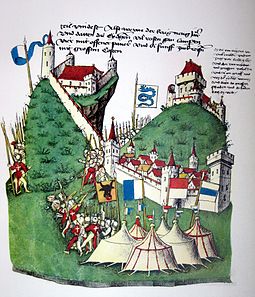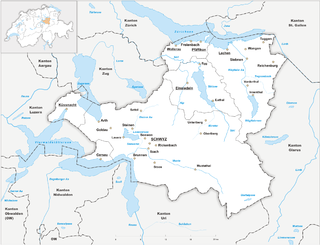
The canton of Schwyz is a canton in central Switzerland between the Alps in the south, Lake Lucerne to the west and Lake Zürich in the north, centred on and named after the town of Schwyz.

The Federal Charter or Letter of Alliance is one of the earliest constitutional documents of Switzerland. A treaty of alliance from 1291 between the cantons of Uri, Schwyz and Unterwalden, the Charter is one of a series of alliances from which the Old Swiss Confederacy emerged. In the 19th and 20th century, after the establishment of the Swiss federal state, the Charter became the central founding document of Switzerland in the popular imagination.

Obwalden or Obwald is one of the 26 cantons forming the Swiss Confederation. It is composed of seven municipalities and the seat of the government and parliament is in Sarnen. It is traditionally considered a "half-canton", the other half being Nidwalden.

The Old Swiss Confederacy began as a late medieval alliance between the communities of the valleys in the Central Alps, at the time part of the Holy Roman Empire, to facilitate the management of common interests such as free trade and to ensure the peace along the important trade routes through the mountains. The Hohenstaufen emperors had granted these valleys reichsfrei status in the early 13th century. As reichsfrei regions, the cantons of Uri, Schwyz, and Unterwalden were under the direct authority of the emperor without any intermediate liege lords and thus were largely autonomous.
The wars of Kappel (Kappelerkriege) is a collective term for two armed conflicts fought near Kappel am Albis between the Catholic and the Protestant cantons of the Old Swiss Confederacy during the Reformation in Switzerland.
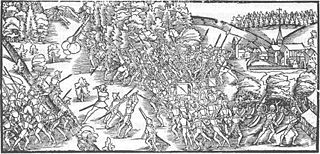
The Second War of Kappel was an armed conflict in 1531 between the Catholic and the Protestant cantons of the Old Swiss Confederacy during the Reformation in Switzerland.
The Pfaffenbrief is a contract dated to October 7, 1370, between six states of the Old Swiss Confederacy, Zürich, Lucerne, Zug, Uri, Schwyz and Unterwalden.

The Rütli Oath is the legendary oath taken at the foundation of the Old Swiss Confederacy by the representatives of the three founding cantons, Uri, Schwyz and Unterwalden, It is named after the site of the oath taking, the Rütli, a meadow above Lake Uri near Seelisberg. Recorded in Swiss historiography from the 15th century, the oath is notably featured in the 19th century play William Tell by Friedrich Schiller.

The Old Swiss Confederacy, also known as Switzerland or the Swiss Confederacy, was a loose confederation of independent small states, initially within the Holy Roman Empire. It is the precursor of the modern state of Switzerland.

The Battle of Crevola was fought in the spring of 1487, between a marauding Swiss army from the Valais and Lucerne and troops from the Duchy of Milan, for the supremacy of the Val d'Ossola (Eschental).

Vogtei Rheintal was a condominium of the Old Swiss Confederacy from the 15th century until 1798. Its territory corresponded to the left banks of the Alpine Rhine between Hoher Kasten and Lake Constance, including the towns of Altstätten and Rheineck.
The Pact of Brunnen is a historical treaty between the cantons of Uri, Schwyz, Unterwalden, concluded in Brunnen on 9 December 1315.

The transalpine campaigns of the Old Swiss Confederacy were military expeditions which resulted in the conquest of territories south of the Alps, corresponding more or less to the modern canton of Ticino, on the part of the Old Swiss Confederacy in the 15th and 16th centuries. These territories were known as ennetbirgische Vogteien or "transmontane bailiwicks".

The Saubannerzug was a military campaign of irregular Swiss forces during the Fasnacht period of the year 1477, in the aftermath of the Battle of Nancy. It consisted of disgruntled men-at-arms from Central Switzerland who moved towards Geneva to enforce the payment of a sum of 24,000 Gulden owed to the Old Swiss Confederacy as ransom to escape looting.

The Raron affair was a 15th-century rebellion in the Valais against the power of a local noble family, the Raron family. The rebellion brought several cantons of the Swiss Confederation into conflict with each other and threatened a civil war in the Confederation. While Bern was initially successful, they were eventually forced to surrender most of their gains.
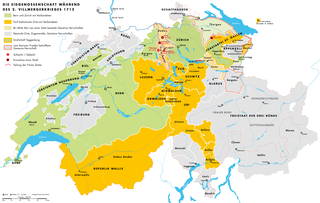
The Toggenburg War, also known as the Second War of Villmergen or the Swiss Civil War of 1712, was a Swiss civil war during the Old Swiss Confederacy from 12 April to 11 August 1712. The Catholic "inner cantons" and the Imperial Abbey of Saint Gall fought the Protestant cantons of Bern and Zürich as well as the abbatial subjects of Toggenburg. The conflict was a religious war, a war for hegemony in the Confederacy and an uprising of subjects. The war ended in a Protestant victory and upset the balance of political power within the Confederacy.
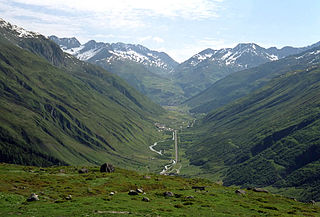
Uri is a Swiss Talschaft and canton in the upper Reuss valley.

The Second Battle of Ulrichen was fought in 1419 between the Old Swiss Confederacy led by Bern and rebels from Valais near Ulrichen in the district of Goms in the canton of Valais in Switzerland. Negotiations after the battle led to the end of the Raron affair and self-determination for Valais.
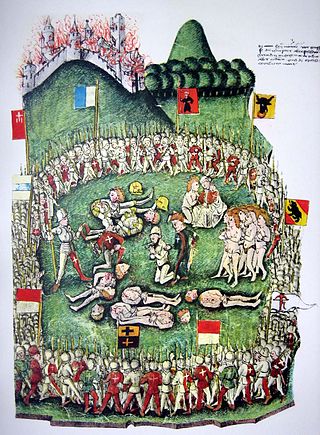
Ital Reding the Elder was Landammann of Schwyz and the leader of the forces of Schwyz during the Old Zürich War (1440–1450).

Swiss Associates, also known as Associated Places,Zugewandte Orte, or Pays Alliés, were associate states of the Old Swiss Confederacy, with some form of alliance agreement with either the entire Confederation or individual cantons.
